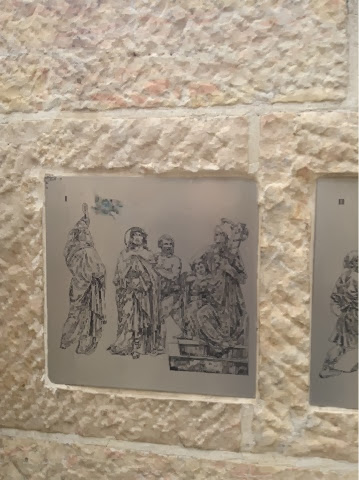The first station^^^
The second station^^^
After that, we we through the tunnels of Old Jerusalem.
The view^^^
Pillar from Herodian times^^^
There really wasn't much to see in the tunnels except for cisterns and rocks.
The healing pools of Bethseda. This is actually where Jesus performed some of his miracles.^^^
Right next to the pools is St. Anne's Church. It is supposedly where Mary was born.
Outside of the church^^^
Statue of Mary and Jesus and the candles that you can light when you go into the church.^^^
Looking up^^^
Looking out the door^^^
The altar^^^
The place where you could kneel and pray (on the left hand side)^^^
Statue of someone (to the left)^^^
The supposed actual birthplace^^^
Statue of Mary^^^
Afterwards, we had to leave through the St. Stephen gate (this one is for you, Dad). It is also called the Lion's Gate.
Do you see the four lions? ^^^
In the afternoon we visited Masada, a huge mesa located at the southern Israeli edge of the Dead Sea. It was here, in about 70 A.D., that the last of the Jewish zealots were encamped while the Roman army was crushing the rebel holdouts in Jerusalem. There were 960 people encamped on the Masada, on which was one of King Herod's several palaces and fortifications. Herod had sufficient provisions of food and water to last for 3 years. A huge Roman detachment was ordered to harass the Jews until they surrendered. History is a bit uncertain as to the time lapse between the beginning and end of the siege. However it is known that the Roman army eventually built sufficient ramps and artillery to smash down the walls and burn the gates. The Jews in view of defeat devised a plan to die honorably instead of giving the Romans the pleasure of a final massacre. The men killed their wives and children and the final ten men killed each other. The final man had to kill himself. It is believed that two women and three children hid out in a very deep cistern and were later freed. The ruins include Herod's palaces, the bathhouses, the garden area, the large storehouses, the columbarium, the cisterns, a later church, and a military area. The Roman encampment and ramp areas below are visible, and the lay of the land suggests how the water was captured from nearby rivers. Access to the top was by the Snake Path, a long and dangerous climb. Today, cable cars take tourists and workers up and down in safety and comfort. Our day was perfect, being warm and partly cloudy, without much wind. On the way back to Jerusalem, we stopped at En Gedi, where David was being chased by King Saul, as recorded in the book of Samuel. A bit further down the road, our bus broke down, but we were soon rescued and safely back in Jerusalem.
A model of what it would've looked like^^^
Bathhouse with original paint^^^
Original tile^^^
The view overlooking one of the levels of the palace^^^
The view^^^
King Herod's bedroom; definitely a room with a view^^^
The storehouses^^^
Cool jug; called a special name because of its two handles, but I can't remember what it is called^^^
View again^^^
Yet another old mosaic^^^
My mom and I in front of the view and the Dead Sea^^^
Tomorrow we are going to Jericho and Bethlehem.
P.S. I was walking and I saw a woman in a head scarf and a dress that reached up to her neck, past her wrists, and down to her ankles. The interesting thing about it was that she had spike stiletto Christian Louboutins on. It was just kinda funny how she mixed something very non-traditional with something very traditional.
-Meghan and Carol































Hi travelers!
ReplyDeleteCovered they may be, but the ladies likely had "Western" clothing on underneath the chador, which is the traditional scarf/dress which covers all but face and hands.